Effects of Typhoon Paths on Storm Surge and Coastal Inundation in the Pearl River Estuary, China
Abstract
1. Introduction
2. Materials and Methods
2.1. Hydrodynamic Model
2.2. Assimilation Typhoon Model
2.3. Data
3. Results and Discussion
3.1. Model Validation
3.2. Sensitivity Experiments on Storm Surge and Coastal Inundation
3.2.1. Different Forcing Fields
3.2.2. Different Typhoon Paths
3.2.3. Moving Speed of Typhoon Center
4. Conclusions
Author Contributions
Funding
Acknowledgments
Conflicts of Interest
References
- Yu, F.; Dong, J.; Ye, L.; Hou, J.; Li, M.; Liu, S.; Wu, S.; Liu, Q.; Fu, X.; Fu, C.; et al. Collection of Storm Surge Disasters Historical Data in China (1949–2009); China Ocean Press: Beijing, China, 2015. [Google Scholar]
- Ministry of Natural Resources of the People’s Republic of China. China Marine Disaster Bulletin in 2016. Available online: http://gc.mnr.gov.cn/201806/t20180619_1798020.html (accessed on 22 March 2018).
- Ministry of Natural Resources of the People’s Republic of China. China Marine Disaster Bulletin in 2017. Available online: http://gc.mnr.gov.cn/201806/t20180619_1798021.html (accessed on 22 March 2018).
- Chen, X.; Zhang, X.; Church, J.A.; Watson, C.S.; King, M.A.; Monselesan, D.; Legresy, B.; Harig, C. The increasing rate of global mean sea–level rise during 1993–2014. Nat. Clim. Chang. 2017, 7, 492–495. [Google Scholar] [CrossRef]
- Emanuel, K.A. Downscaling CMIP5 climate models shows increased tropical cyclone activity over the 21st century. Proc. Natl. Acad. Sci. USA 2013, 110, 12219–12224. [Google Scholar] [CrossRef] [PubMed]
- Guan, S.; Li, S.; Hou, Y.; Hu, P.; Liu, Z.; Feng, J. Increasing threat of landfalling typhoons in the western north pacific between 1974 and 2013. Int. J. Appl. Earth Obs. Geoinf. 2018, 68, 279–286. [Google Scholar] [CrossRef]
- Hallegatte, S.; Green, C.; Nicholls, R.J.; Corfee–Morlot, J. Future flood losses in major coastal cities. Nat. Clim. Chang. 2013, 3, 802–806. [Google Scholar] [CrossRef]
- Sweet, W.V.; Kopp, R.E.; Weaver, C.P.; Obeysekera, J.; Horton, R.M.; Thieler, E.R.; Zervas, C. Global and Regional Sea Level Rise Scenarios for the United States (NOAA Technical Report NOS CO–OPS 083); Washington, DC, 2017. Available online: https://ntrs.nasa.gov/archive/nasa/casi.ntrs.nasa.gov/20180001857.pdf (accessed on 23 February 2020).
- Qi, P.; Du, M. Multi–factor evaluation indicator method for the risk assessment of atmospheric and oceanic hazard group due to the attack of tropical cyclones. Int. J. Appl. Earth Obs. Geoinf. 2018, 68, 1–7. [Google Scholar] [CrossRef]
- Bukvic, A.; Rohat, G.; Apotsos, A.; de Sherbinin, A. A Systematic Review of Coastal Vulnerability Mapping. Sustainability 2020, 12, 2822. [Google Scholar] [CrossRef]
- Dedekorkut–Howes, A.; Torabi, E.; Howes, M. When the tide gets high: A review of adaptive responses to sea level rise and coastal flooding. J. Environ. Plan. Manag. 2020, 1–42. [Google Scholar] [CrossRef]
- Wang, H.; Loftis, J.; Liu, Z.; Forrest, D.; Zhang, J. The Storm Surge and Sub–Grid Inundation Modeling in New York City during Hurricane Sandy. J. Mar. Sci. Eng. 2014, 2, 226–246. [Google Scholar] [CrossRef]
- Yin, J.; Lin, N.; Yu, D. Coupled modeling of storm surge and coastal inundation: A case study in New York City during Hurricane Sandy. Water Resour. Res. 2016, 52, 8685–8699. [Google Scholar] [CrossRef]
- Dietrich, J.C.; Bunya, S.; Westerink, J.J.; Ebersole, B.A.; Smith, J.M.; Atkinson, J.H.; Jensen, R.; Resio, D.T.; Luettich, R.A.; Dawson, C.; et al. A high–resolution coupled riverine flow, tide, wind, wind wave, and storm surge model for southern Louisiana and Mississippi. Part II: Synoptic description and analysis of Hurricanes Katrina and Rita. Mon. Weather Rev. 2010, 138, 378–404. [Google Scholar] [CrossRef]
- Sheng, Y.P.; Zhang, Y.; Paramygin, V.A. Simulation of storm surge, wave, and coastal inundation in the northeastern Gulf of Mexico region during hurricane Ivan in 2004. Ocean Model. 2010, 35, 314–331. [Google Scholar] [CrossRef]
- Bilskie, M.V.; Hagen, S.C.; Medeiros, S.C.; Cox, A.T.; Salisbury, M.; Coggin, D. Data and numerical analysis of astronomic tides, wind-waves, and hurricane storm surge along the northern Gulf of Mexico. J. Geophys. Res. Ocean. 2016, 121, 3625–3658. [Google Scholar] [CrossRef]
- Bhaskaran, P.K.; Gayathri, R.; Murty, P.L.N.; Bonthu, S.R.; Sen, D. A numerical study of coastal inundation and its validation for Thane cyclone in the Bay of Bengal. Coast. Eng. 2014, 83, 108–118. [Google Scholar] [CrossRef]
- Bhaskaran, P.K.; Nayak, S.; Bonthu, S.R.; Murty, P.N.; Sen, D. Performance and validation of a coupled parallel ADCIRC–SWAN model for THANE cyclone in the Bay of Bengal. Environ. Fluid Mech. 2013, 13. [Google Scholar] [CrossRef]
- Gayathri, R.; Bhaskaran, P.K.; Sen, D. Numerical study on storm surge and associated coastal inundation for 2009 AILA cyclone in the Head Bay of Bengal. Aquat. Procedia 2015, 4, 404–411. [Google Scholar] [CrossRef]
- Yin, J.; Yin, Z.E.; Hu, X.M.; Xu, S.Y.; Wang, J.; Li, Z.H.; Zhong, H.D.; Gan, F.B. Multiple scenario analyses forecasting the confounding impacts of sea level rise and tides from storm induced coastal flooding in the city of Shanghai, China. Environ. Earth Sci. 2011, 63, 407–414. [Google Scholar] [CrossRef]
- Pan, Z.; Liu, H. Extreme storm surge induced coastal inundation in Yangtze Estuary regions. J. Hydrodyn. 2019, 31, 1127–1138. [Google Scholar] [CrossRef]
- Wang, K.; Hou, Y.; Li, S.; Du, M.; Li, R. Numerical Study of Storm Surge Inundation in the Southwestern Hangzhou Bay Region During Typhoon Chan–Hom in 2015. J. Ocean Univ. China 2020, 19, 263–271. [Google Scholar] [CrossRef]
- Li, L.; Yang, J.; Lin, C.Y.; Chua, C.T.; Wang, Y.; Zhao, K.; Wu, Y.T.; Liu, P.L.; Switzer, A.D.; Mok, K.M.; et al. Field survey of Typhoon Hato (2017) and a comparison with storm surge modeling in Macau. Nat. Hazards Earth Syst. Sci. 2018, 18, 3167–3178. [Google Scholar] [CrossRef]
- Yang, J.; Li, L.; Zhao, K.; Wang, P.; Wang, D.; Sou, I.M.; Yang, Z.; Hu, J.; Tang, X.; Mok, K.M.; et al. A Comparative Study of Typhoon Hato (2017) and Typhoon Mangkhut (2018)—Their Impacts on Coastal Inundation in Macau. J. Geophys. Res. Ocean. 2019. [Google Scholar] [CrossRef]
- Yin, K.; Xu, S.; Huang, W.; Xie, Y. Effects of sea level rise and typhoon intensity on storm surge and waves in Pearl River Estuary. Ocean Eng. 2017, 136, 80–93. [Google Scholar] [CrossRef]
- Li, J.; Hou, Y.; Mo, D.; Liu, Q.; Zhang, Y. Influence of Tropical Cyclone Intensity and Size on Storm Surge in the Northern East China Sea. Remote Sens. 2019, 11, 3033. [Google Scholar] [CrossRef]
- Li, A.; Guan, S.; Mo, D.; Hou, Y.; Hong, X.; Liu, Z. Modeling wave effects on storm surge from different typhoon intensities and sizes in the South China Sea. Estuar. Coast. Shelf Sci. 2020, 235, 106551. [Google Scholar] [CrossRef]
- Du, M.; Hou, Y.; Qi, P.; Wang, K. The impact of different historical typhoon tracks on storm surge: A case study of Zhejiang, China. J. Mar. Syst. 2020, 103318. [Google Scholar] [CrossRef]
- Feng, X.; Yin, B.; Yang, D. Effect of hurricane paths on storm surge response at Tianjin, china. Estuar. Coast. Shelf Sci. 2012, 106. [Google Scholar] [CrossRef]
- Lin, N.; Emanuel, K.A.; Smith, J.A.; Vanmarcke, E. Risk assessment of hurricane storm surge for new york city. J. Geophys. Res. Atmos. 2010, 115. [Google Scholar] [CrossRef]
- Wang, Y.; Mao, X.; Jiang, W. Long–term hazard analysis of destructive storm surges using the ADCIRC–SWAN model: A case study of Bohai Sea, China. Int. J. Appl. Earth Obs. Geoinf. 2018, 73, 52–62. [Google Scholar] [CrossRef]
- Wang, K.; Hou, Y.; Li, S.; Du, M.; Chen, J.; Lu, J. A comparative study of storm surge and wave setup in the East China Sea between two severe weather events. Estuar. Coast. Shelf Sci. 2020. [Google Scholar] [CrossRef]
- Holland, G. An analytic model of the wind and pressure profiles in hurricanes. Mon. Weather Rev. 1980, 108, 1212–1218. [Google Scholar] [CrossRef]
- Jelesnianski, C.P. A numerical computation of storm tides induced by a tropical storm impinging on a continental shelf. Mon. Weather Rev. 1965, 93, 343–358. [Google Scholar] [CrossRef]
- Wang, X.; Qian, C.; Wang, W.; Yan, T. An elliptical wind field model of typhoons. J. Ocean Univ. China 2004, 3, 33–39. [Google Scholar] [CrossRef]
- Xie, L.; Bao, S.; Pietrafesa, L.J.; Foley, K.; Fuentes, M. A real–time hurricane surface wind forecasting model: Formulation and verification. Mon. Weather Rev. 2006, 134, 1355–1370. [Google Scholar] [CrossRef]
- Luettich, R.A., Jr.; Westerink, J.J.; Scheffner, N.W. ADCIRC: An Advanced Three–Dimensional Circulation Model for Shelves, Coasts, and Estuaries. Report 1. Theory and Methodology of ADCIRC–2DDI and ADCIRC–3DL (No. CERC–TR–DRP–92–6). Coastal Engineering Research Center Vicksburg MS. 1992. Available online: https://babel.hathitrust.org/cgi/pt?id=uc1.31210025019819&view=1up&seq=1 (accessed on 27 February 2020).
- Westerink, J.J.; Luettich, R.A., Jr.; Blain, C.A.; Scheffner, N.W. ADCIRC: An Advanced Three–Dimensional Circulation Model for Shelves, Coasts, and Estuaries. Report 2. User’s Manual for ADCIRC–2DDI (No. WES/TR/DRP–92–6–2). Army Engineer Waterways Experiment Station Vicksburg MS. 1994. Available online: https://babel.hathitrust.org/cgi/pt?id=uc1.31210018603462&view=1up&seq=7 (accessed on 3 March 2020).
- Suh, S.W.; Lee, H.Y.; Kim, H.J. Spatio–temporal variability of tidal asymmetry due to multiple coastal constructions along the west coast of Korea. Estuar. Coast. Shelf Sci. 2014, 151, 336–346. [Google Scholar] [CrossRef]
- Booij, N.; Ris, R.; Holthuijsen, L. A third–generation wave model for coastal regions: 1: Model description and validation. J. Geophys. Res. Ocean. 1999, 104, 7649–7666. [Google Scholar] [CrossRef]
- Ris, R.; Booij, N.; Holthuijsen, L. A third–generation wave model for coastal regions, 2. verification. J. Geophys. Res. Ocean. 1999, 104, 7667–7681. [Google Scholar] [CrossRef]
- Dietrich, J.C.; Tanaka, S.; Westerink, J.J.; Dawson, C.N.; Luettich, R.A.; Zijlema, M.; Holthuijsen, L.H.; Smith, J.M.; Westerink, L.G.; Westerink, H.J. Performance of the unstructured–mesh, swan+adcirc model in computing hurricane waves and surge. J. Sci. Comput. 2012, 52, 468–497. [Google Scholar] [CrossRef]
- Willoughby, H.E.; Rahn, M.E. Parametric representation of the primary hurricane vortex. Part I: Observations and evaluation of the Holland (1980) model. Mon. Weather Rev. 2004, 132, 3033–3048. [Google Scholar] [CrossRef]
- Carr, L.E.; Elsberry, R.L. Models of tropical cyclone wind distribution and beta–effect propagation for application to tropical cyclone track forecasting. Mon. Weather Rev. 1997, 125, 3190–3209. [Google Scholar] [CrossRef]
- Ying, M.; Zhang, W.; Yu, H.; Lu, X.; Feng, J.; Fan, Y.; Zhu, Y.; Chen, D. An overview of the China Meteorological Administration tropical cyclone database. J. Atmos. Ocean. Technol. 2014, 31, 287–301. [Google Scholar] [CrossRef]
- Saha, S.; Moorthi, S.; Pan, H.; Wu, X.; Wang, J.; Nadiga, S.; Tripp, P.; Kistler, R.; Woollen, J.; Behringer, D.; et al. NCEP Climate Forecast System Reanalysis (CFSR) Selected Hourly Time–Series Products, January 1979 to December 2010. Research Data Archive at the National Center for Atmospheric Research, Computational and Information Systems Laboratory. 2010. Available online: https://doi.org/10.5065/D6513W89 (accessed on 3 March 2020).
- Saha, S.; Moorthi, S.; Wu, X.; Wang, J.; Nadiga, S.; Tripp, P.; Behringer, D.; Hou, Y.; Chuang, H.; Iredell, M.; et al. NCEP Climate Forecast System Version 2 (CFSv2) Selected Hourly Time–Series Products. Research Data Archive at the National Center for Atmospheric Research, Computational and Information Systems Laboratory. 2011. Available online: https://doi.org/10.5065/D6N877VB (accessed on 6 March 2020).
- Bilskie, M.V.; Hagen, S.C.; Alizad, K.; Medeiros, S.C.; Passeri, D.L.; Needham, H.F.; Cox, A. Dynamic simulation and numerical analysis of hurricane storm surge under sea level rise with geomorphologic changes along the northern Gulf of Mexico. Earth’s Future 2016, 4, 177–193. [Google Scholar] [CrossRef]
- Ding, Y.; Wei, H. Modeling the impact of land reclamation on storm surges in Bohai Sea, China. Nat. Hazards 2017, 85, 559–573. [Google Scholar] [CrossRef]
- Shen, Y.; Jia, H.; Li, C.; Tang, J. Numerical simulation of saltwater intrusion and storm surge effects of reclamation in Pearl River Estuary, China. Appl. Ocean Res. 2018, 79, 101–112. [Google Scholar] [CrossRef]
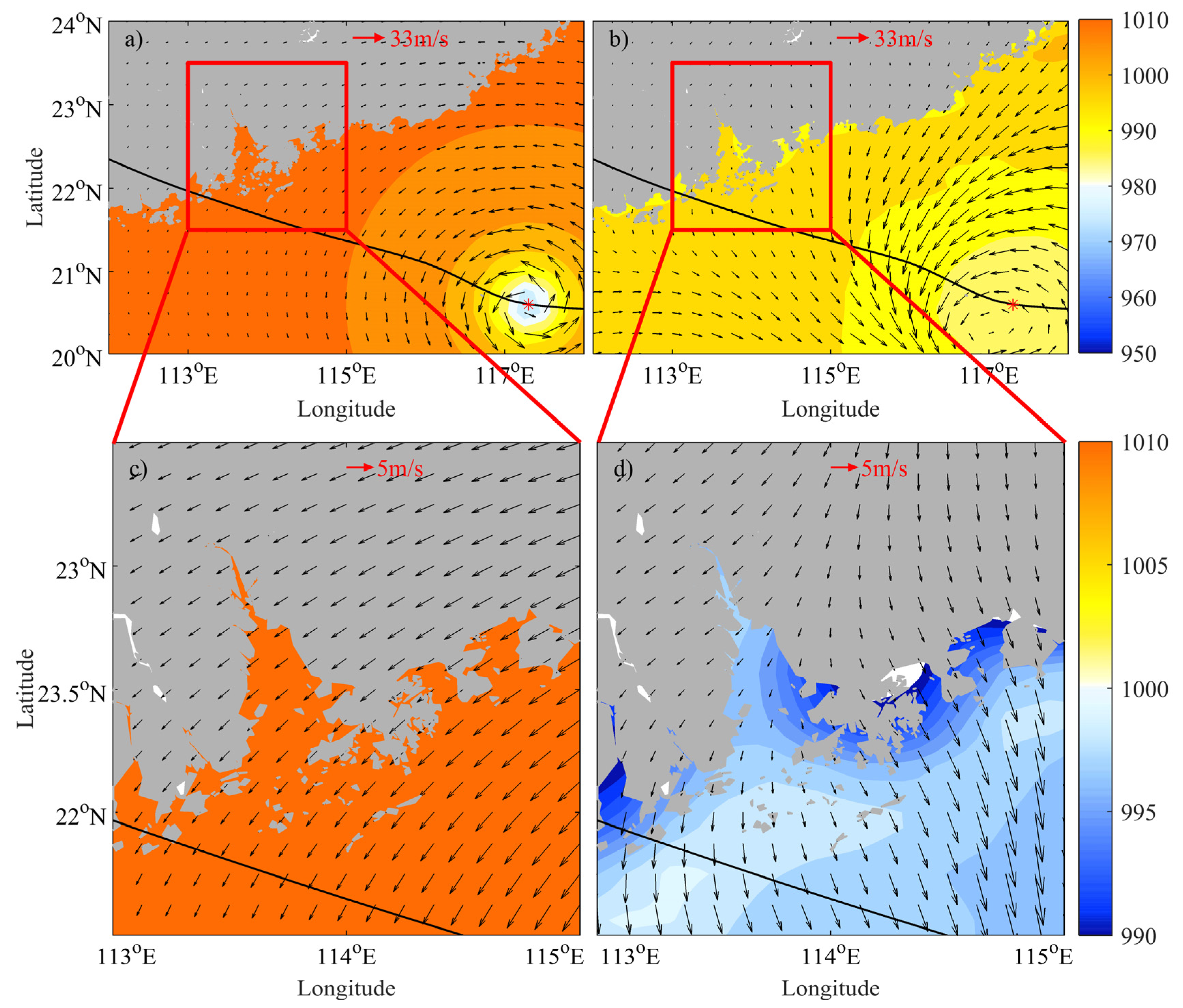
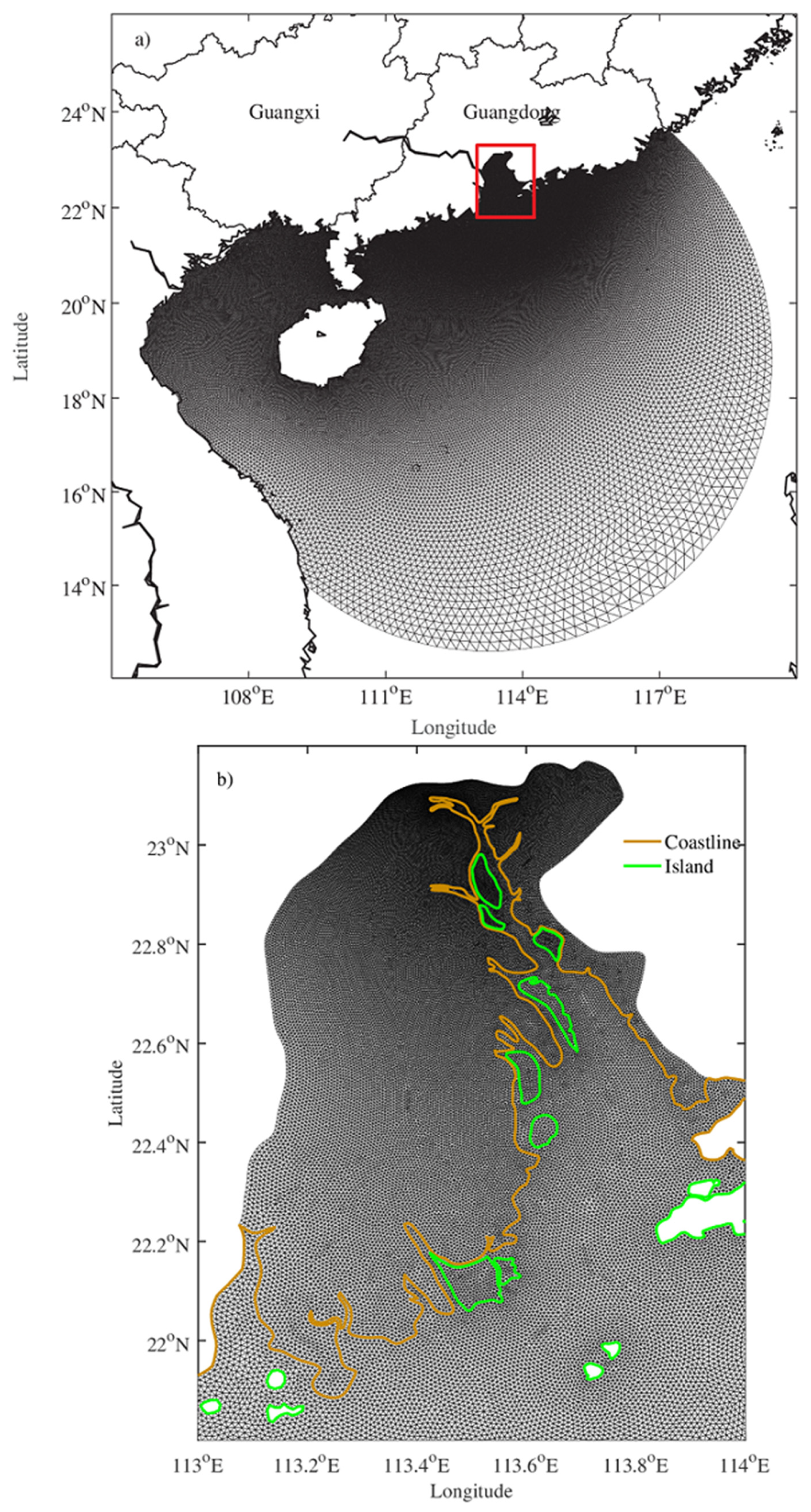
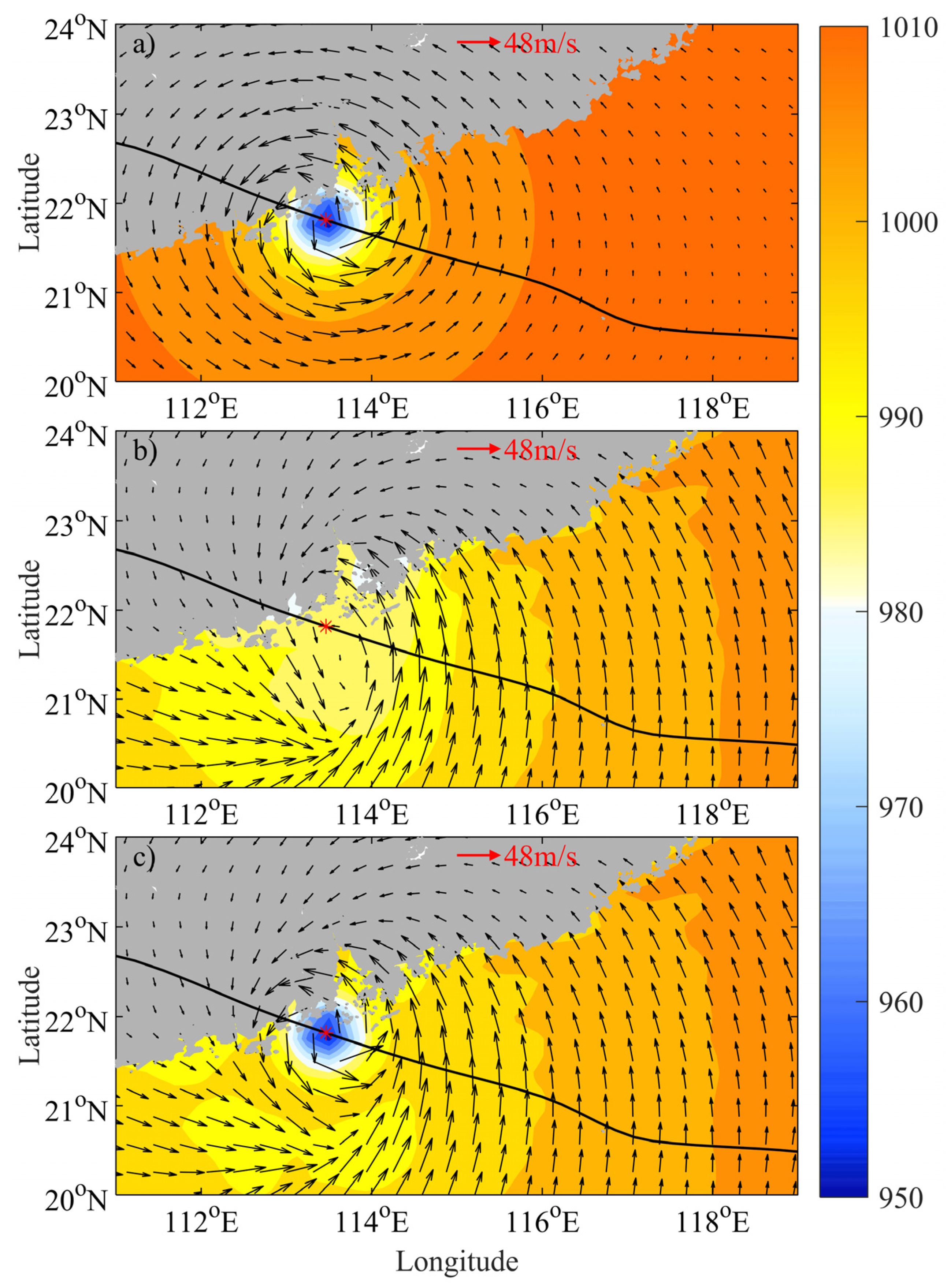
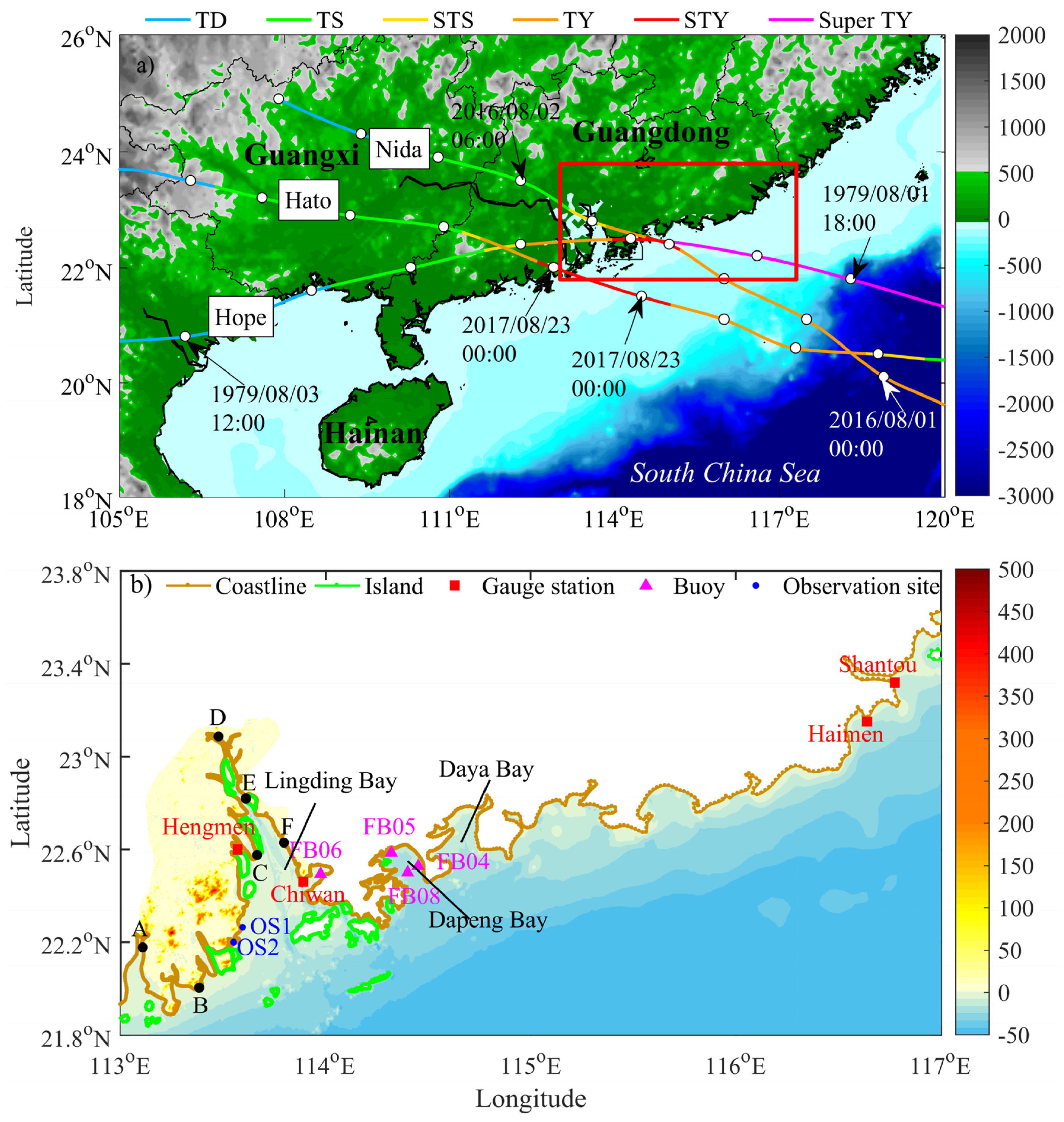
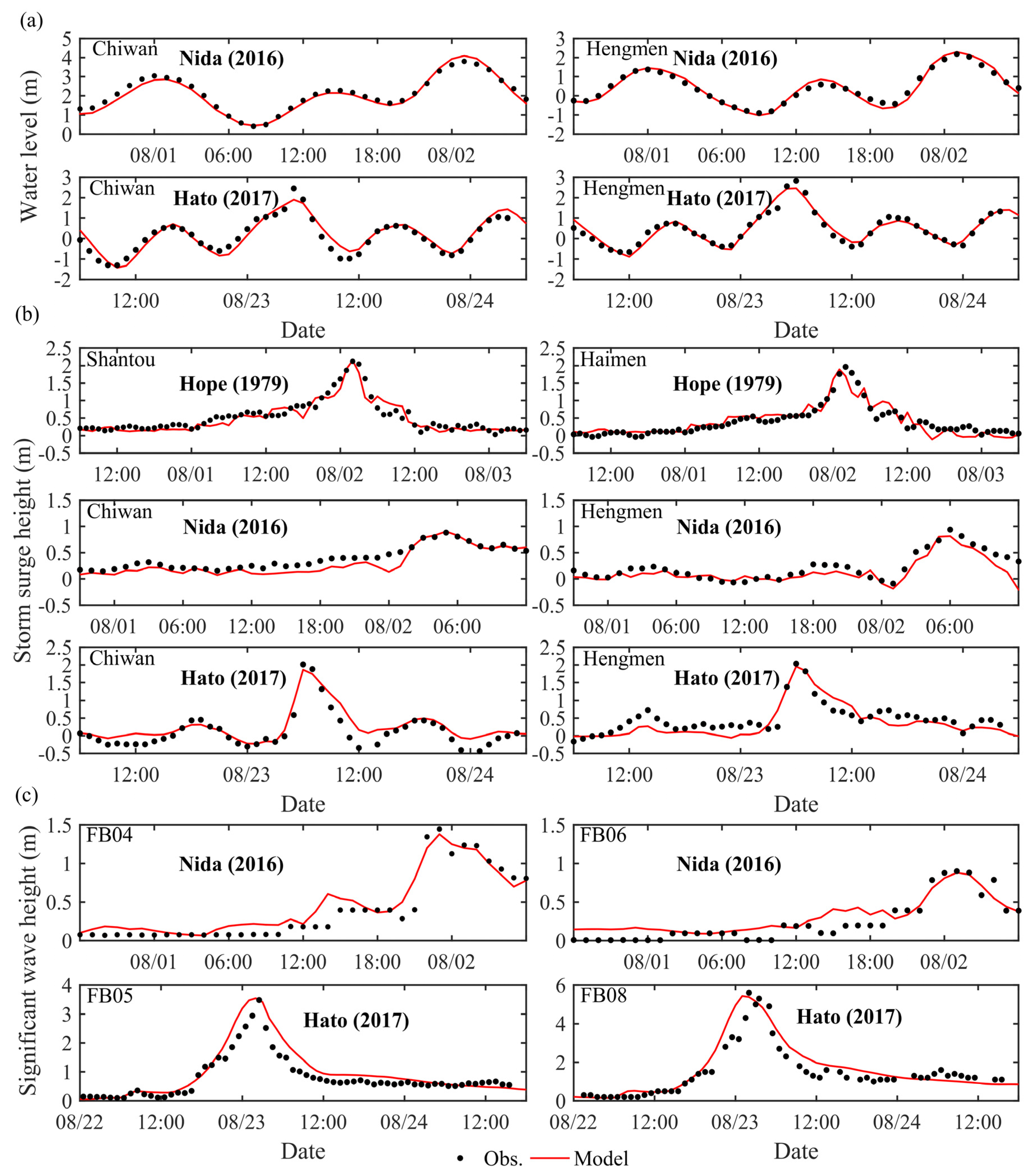
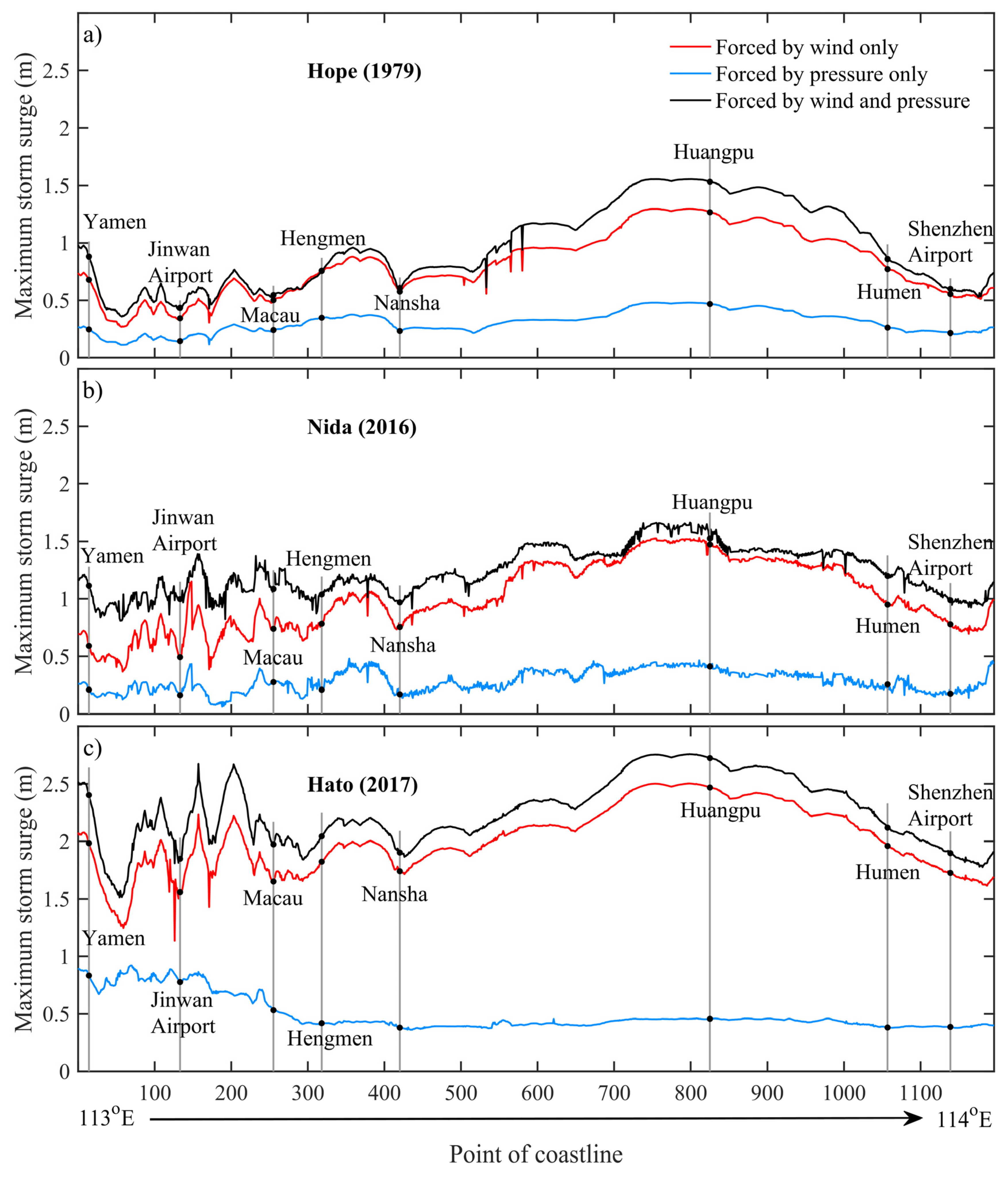
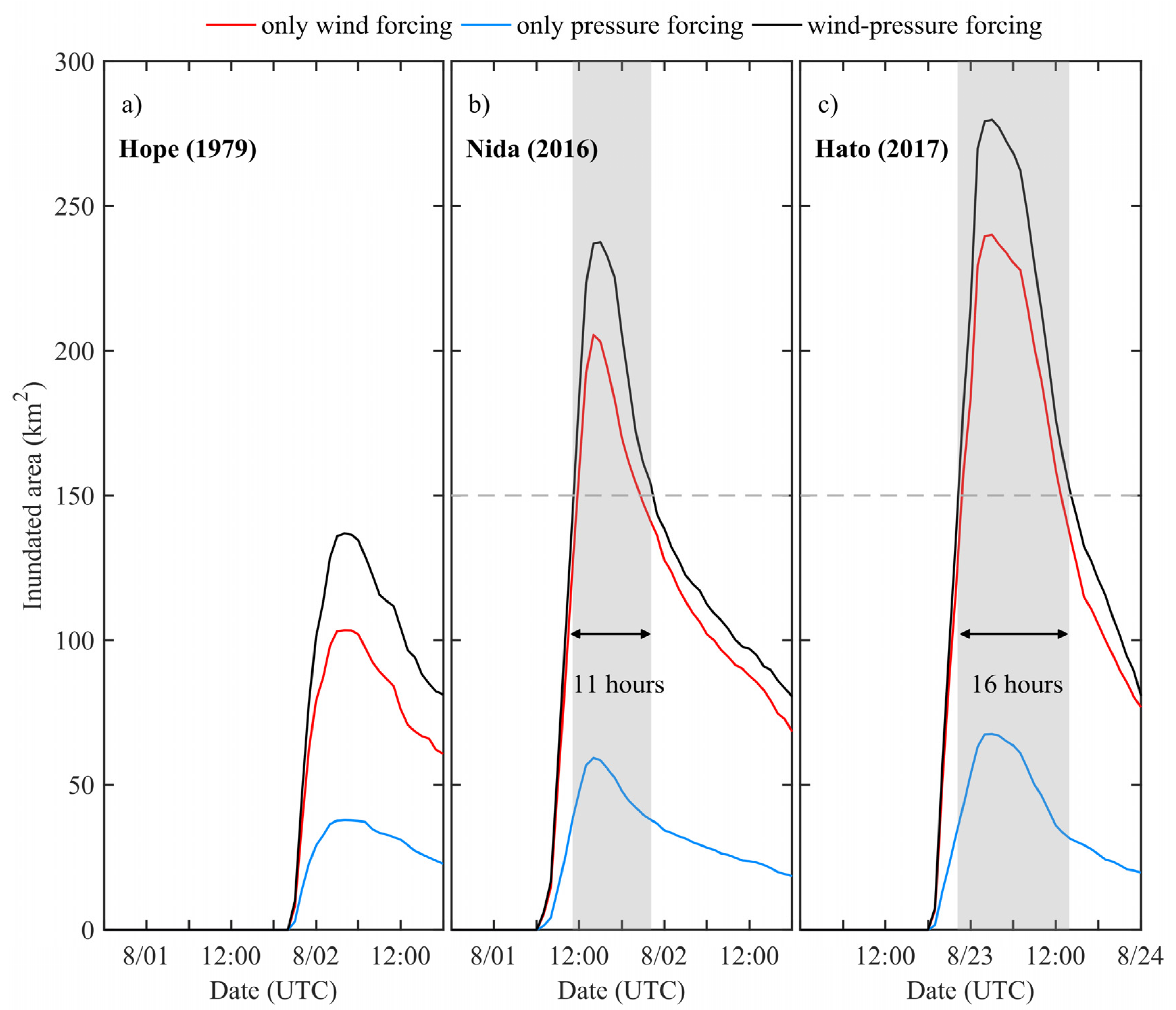
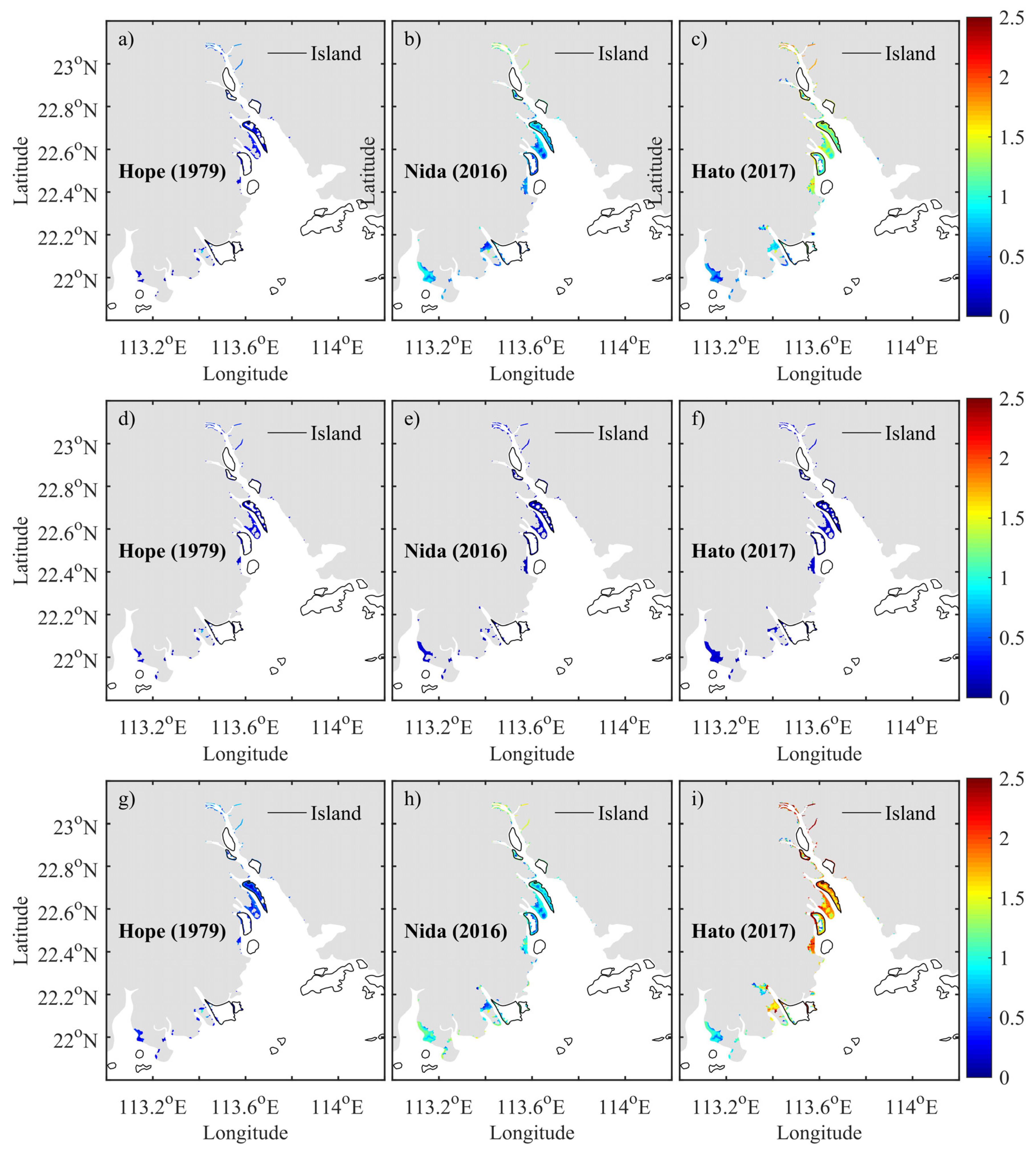
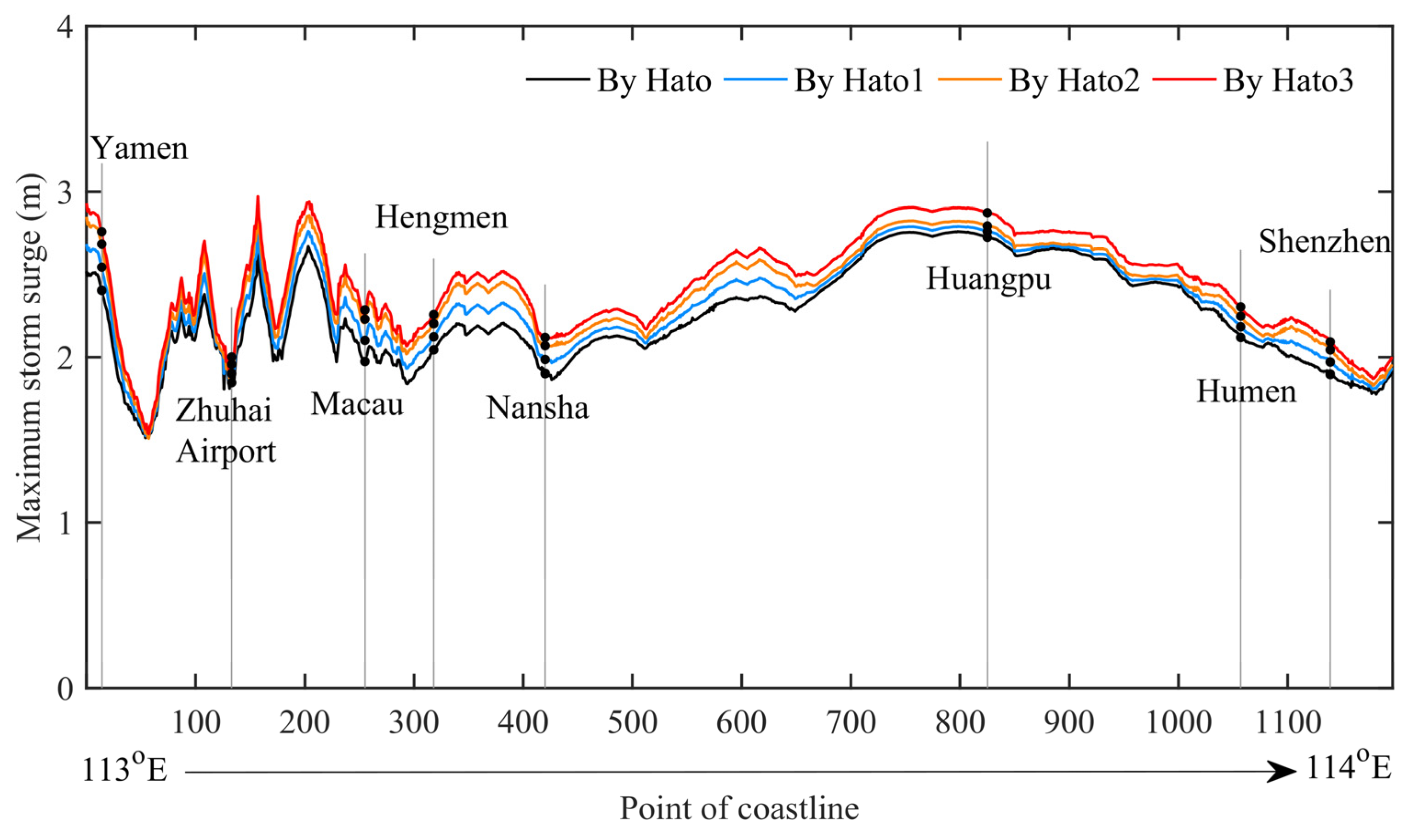
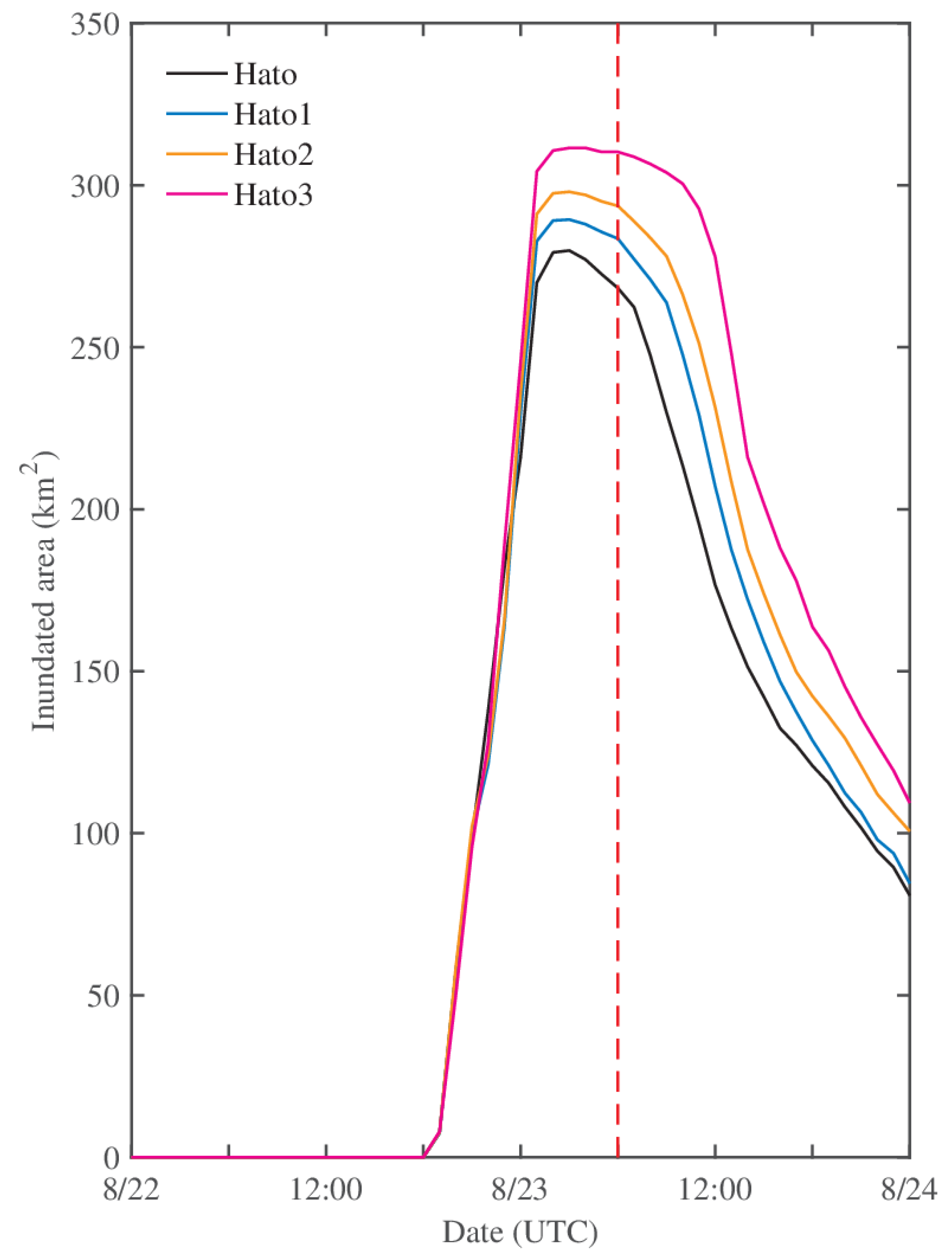
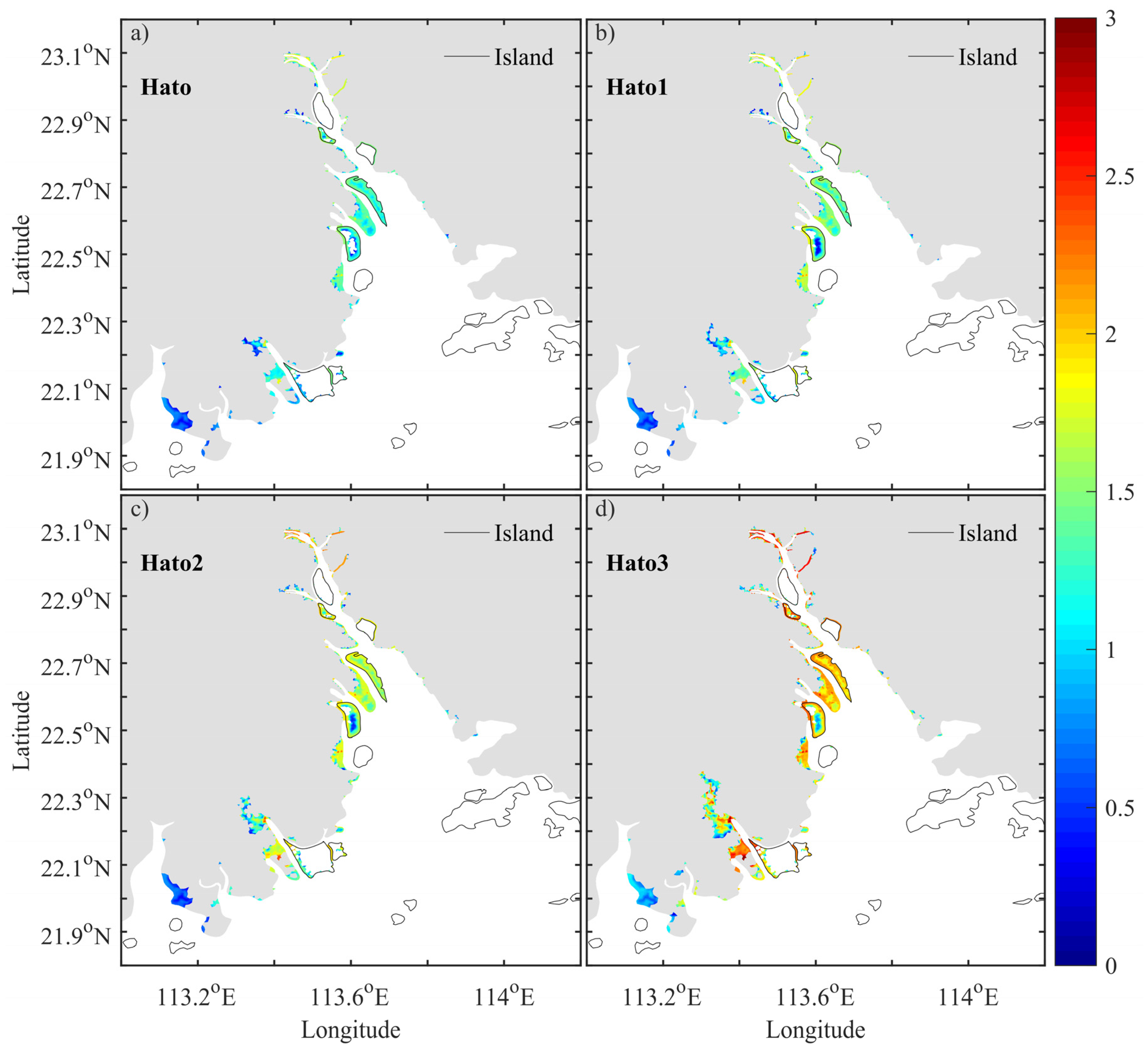
| Item | Typhoon Hope (1979) | Typhoon Nida (2016) | Typhoon Hato (2017) |
|---|---|---|---|
| Maximum intensity on the CMA typhoon wind scale | Super Typhoon 1979/7/31 12:00–8/2 00:00 UTC Over waters east of the Philippines to the PRE waters | Strong Typhoon 2016/8/1 18:00–19:00 UTC Over the PRE waters | Strong Typhoon 2017/8/22 23:00–8/23 06:00 UTC Over the PRE waters |
| Track forward direction | From ESE to WNW | From ESE to WNW | From ESE to WNW |
| Minimum central pressure (hPa) | 898 | 960 | 940 |
| Maximum wind speed (m/s) | 70 | 42 | 48 |
| Landfall location and time | Dapeng Peninsula, Shenzhen City, Guangdong Province, China, 13:35 on 2 August 1979 | Dapeng Peninsula, Shenzhen City, Guangdong Province, China, 19:35 on 1 August 2016 | Jinwan District, Zhuhai City, Guangdong Province, China, 04:50 on 23 August 2017 |
| Typhoon | Position | Comparison of the Peak Values | Comparison of All the Time Series | ||
|---|---|---|---|---|---|
| AE (m) | RE | RMSE (m) | CC | ||
| Hope (1979) | Shantou | 0.03 | 1.18% | 0.17 | 0.94 |
| Hope (1979) | Haimen | 0.07 | 3.74% | 0.18 | 0.91 |
| Nida (2016) | Chiwan | 0.02 | 2.39% | 0.12 | 0.95 |
| Nida (2016) | Hengmen | 0.03 | 3.75% | 0.14 | 0.90 |
| Nida (2016) | FB04 | 0.06 | 4.57% | 0.12 | 0.97 |
| Nida (2016) | FB06 | 0.02 | 2.25% | 0.13 | 0.92 |
| Hato (2017) | Chiwan | 0.15 | 7.84% | 0.24 | 0.93 |
| Hato (2017) | Hengmen | 0.07 | 3.90% | 0.22 | 0.90 |
| Hato (2017) | FB05 | 0.02 | 0.75% | 0.27 | 0.98 |
| Hato (2017) | FB08 | 0.19 | 3.43% | 0.50 | 0.95 |
| Observation Site | Typhoon | Maximum Inundation Depth (m) | Difference (m) | Distance from Inundated Place to Coastline (m) | Difference (m) | |||
|---|---|---|---|---|---|---|---|---|
| Obs. | Model | Obs. | Model | |||||
| OS1 | Lover Road Bathing Beach, Zhuhai City | Nida (2016) | 2.1 | 2.21 | +0.11 | 65 | 75 | +10 |
| Viewing Platform of the Fishing Girl, Zhuhai City | Nida (2016) | 1.9 | 2.17 | +0.27 | 70 | 85 | +15 | |
| OS2 | Avenida De Demetrio Cinatti, Macao | Hato (2017) | 2.1 | 1.68 | –0.42 | |||
| Parking Lot of New Riverside Street, Macao | Hato (2017) | 2.0 | 1.69 | –0.31 | ||||
© 2020 by the authors. Licensee MDPI, Basel, Switzerland. This article is an open access article distributed under the terms and conditions of the Creative Commons Attribution (CC BY) license (http://creativecommons.org/licenses/by/4.0/).
Share and Cite
Du, M.; Hou, Y.; Hu, P.; Wang, K. Effects of Typhoon Paths on Storm Surge and Coastal Inundation in the Pearl River Estuary, China. Remote Sens. 2020, 12, 1851. https://doi.org/10.3390/rs12111851
Du M, Hou Y, Hu P, Wang K. Effects of Typhoon Paths on Storm Surge and Coastal Inundation in the Pearl River Estuary, China. Remote Sensing. 2020; 12(11):1851. https://doi.org/10.3390/rs12111851
Chicago/Turabian StyleDu, Mei, Yijun Hou, Po Hu, and Kai Wang. 2020. "Effects of Typhoon Paths on Storm Surge and Coastal Inundation in the Pearl River Estuary, China" Remote Sensing 12, no. 11: 1851. https://doi.org/10.3390/rs12111851
APA StyleDu, M., Hou, Y., Hu, P., & Wang, K. (2020). Effects of Typhoon Paths on Storm Surge and Coastal Inundation in the Pearl River Estuary, China. Remote Sensing, 12(11), 1851. https://doi.org/10.3390/rs12111851






